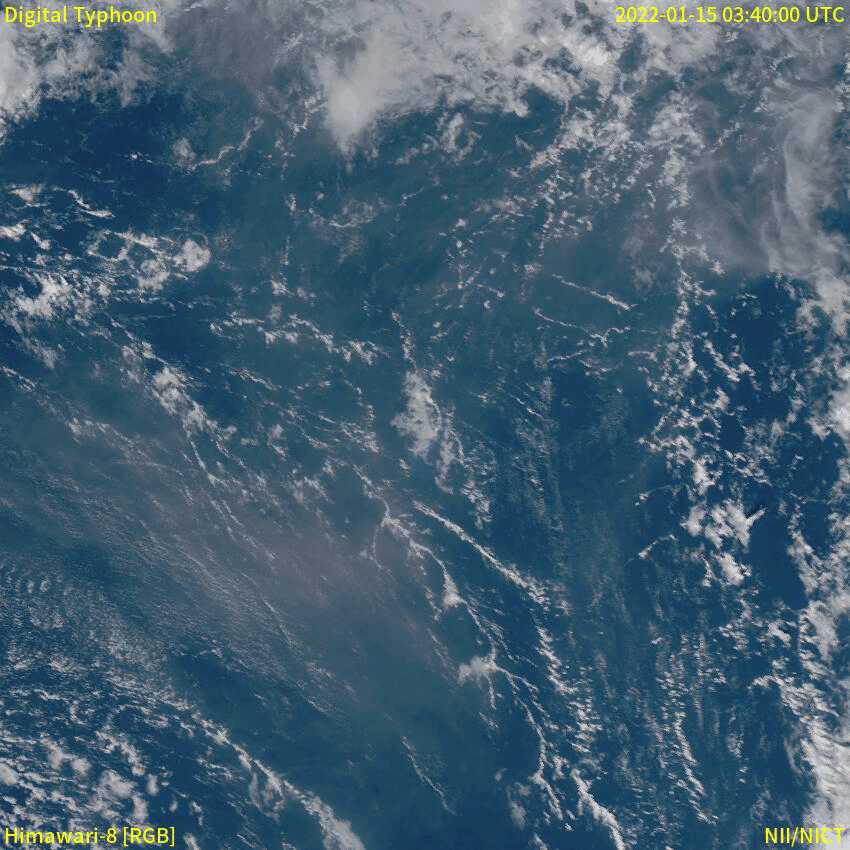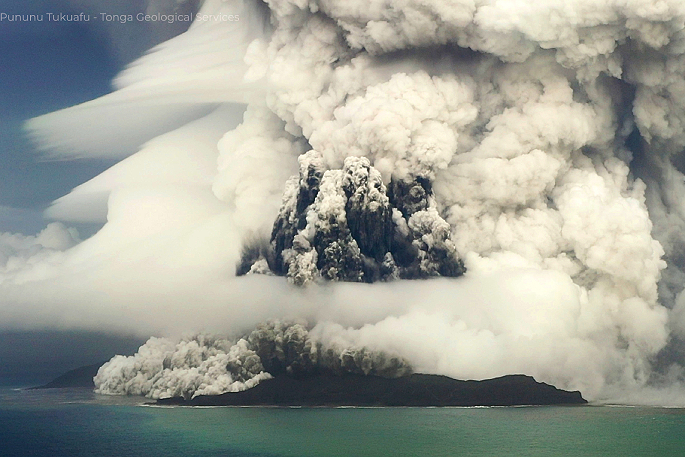Early in the evening of 15 January 2022, Tonga’s Hunga volcano erupted with the largest and most energetic explosion recorded in modern times.
The eruption, which occurred at the same time as Cyclone Cody, caused a far-reaching tsunami that impacted our coastlines and booming sounds that were heard across the globe.
The eruption sent an atmospheric shockwave around the globe several times and was picked up on air pressure sensors as far away as Iceland.
Audible booming could be heard from Aotearoa New Zealand in the south and Alaska in the north.
This was due to the low-frequency bass-like booms produced during the eruption that can travel thousands of kilometres away from the source.
 Himawari-8 satellite images of the 15 January 2022 eruption of Hunga. Credit: Japan Meteorological Agency.
Himawari-8 satellite images of the 15 January 2022 eruption of Hunga. Credit: Japan Meteorological Agency.
Following the event, 2,100 people around Aotearoa New Zealand shared their observations with GNS Science through emails and an online survey.
These crowdsourced observations of tsunami activity and noises associated with the eruption.
In total, 295 tsunami observations and 1751 noise observations were reported by people across New Zealand.
You can view the survey results via interactive StoryMap here.
Our scientists have completed a study that compares these crowdsourced observations to the geophysical monitoring signals picked up by our instruments.
They wanted to see if what people heard matched with what the seismometers and acoustic sensors recorded.
The team found that the two datasets align well, in that they captured similar values for the timing, number, and loudness of the boom sounds.
This suggests that crowdsourcing human observations about eruptions can be a useful and reliable addition to volcano monitoring techniques!
What excited our team was that it showed how human observations can add real value to our understanding of eruption events.
With comprehensive observations across the country, it allowed us to see that the “boom” sounds from the eruption travelled from North to South down Aotearoa New Zealand, and that more and louder booms were heard in the North Island (see below).
 Summary of observations of “boom” sounds across NZ, analysed by distance from Hunga volcano.
Summary of observations of “boom” sounds across NZ, analysed by distance from Hunga volcano.
The observations show us that the pressure wave caused impacts across the country.
Reports of shaking buildings, rattling windows, pressure sensations in the ears and chest, and animal distress indicate that low-pressure vibrations from highly explosive volcanic eruptions can cause notable disturbances thousands of kilometres from the eruption.
The researchers suggest that this warrants further exploration as it may have implications for volcanic eruption modelling, understanding of eruption pressure wave propagation, and hazard and risk.
Nearby in Tonga, survivors noted that the booming sounds helped spur evacuations, potentially saving many lives.
In Aotearoa New Zealand, our results show that the sounds and the disturbances that they caused resulted in many people calling friends, going outdoors, or searching media for information about a potential danger or risk.
Experience played a role in this process, with some participants recalling experiences and oral histories about the Ruapehu and Tarawera eruptions in their responses.
This suggests that eruption “booming” sounds could be an effective auditory cue to reference in preparedness messaging about volcanic hazards.
The findings show how integrating social science and earth science research can lead to improved understandings of natural hazard events.
The crowdsourced observations from the survey helped fill gaps in the instrumental record of the eruption acoustics and created a space for people to participate in the science of this historic event.
Crowdsourcing felt reports has played a key role our understanding earthquake events in Aotearoa New Zealand.
We are excited to explore the future of crowdsourced observations following not only volcanic eruptions, but for all geohazards we face.



1 comment
The Master
Posted on 12-11-2024 08:45 | By Ian Stevenson
Not only was it loud but the plume was recorded as exceeding 50km, well beyond most volcanic eruptions except Super-volcanos like Taupo or Yellow Stone.
Hence as a result, that has impacted the weather, particular as a result of injecting massive volumes of water into the Mesosphere (normally very dry and very cold -15C to -90C). That moisture has to come back down sometime... as rain over perhaps 5-10 years.
Leave a Comment
You must be logged in to make a comment.